SBM4305 Project Management Report: Software Implementation Analysis
VerifiedAdded on 2023/06/08
|13
|3717
|283
Report
AI Summary
This report delves into the intricacies of project management, specifically in the context of implementing new software for a supermarket. It comprehensively covers the 10 project management knowledge areas: integration, scope, schedule, cost, quality, resource, communications, risk, procurement, and stakeholder management, detailing the processes and activities within each area throughout the project lifecycle. The report outlines the essential project management documents, such as the project charter, management plan, and quality management plan. Furthermore, the report addresses the importance of project quality management in managing global teams, emphasizing the need for cultural awareness and adherence to legal issues. The report also discusses the activities that are considered before project closure, ensuring a complete overview of the project management process. This report offers a detailed analysis of project management principles and practices, providing valuable insights into the successful execution of software implementation projects.

Running head: PROJECT MANAGEMENT
Project Management
[Name of the Student]
[Name of the University]
[Author note]
Project Management
[Name of the Student]
[Name of the University]
[Author note]
Secure Best Marks with AI Grader
Need help grading? Try our AI Grader for instant feedback on your assignments.
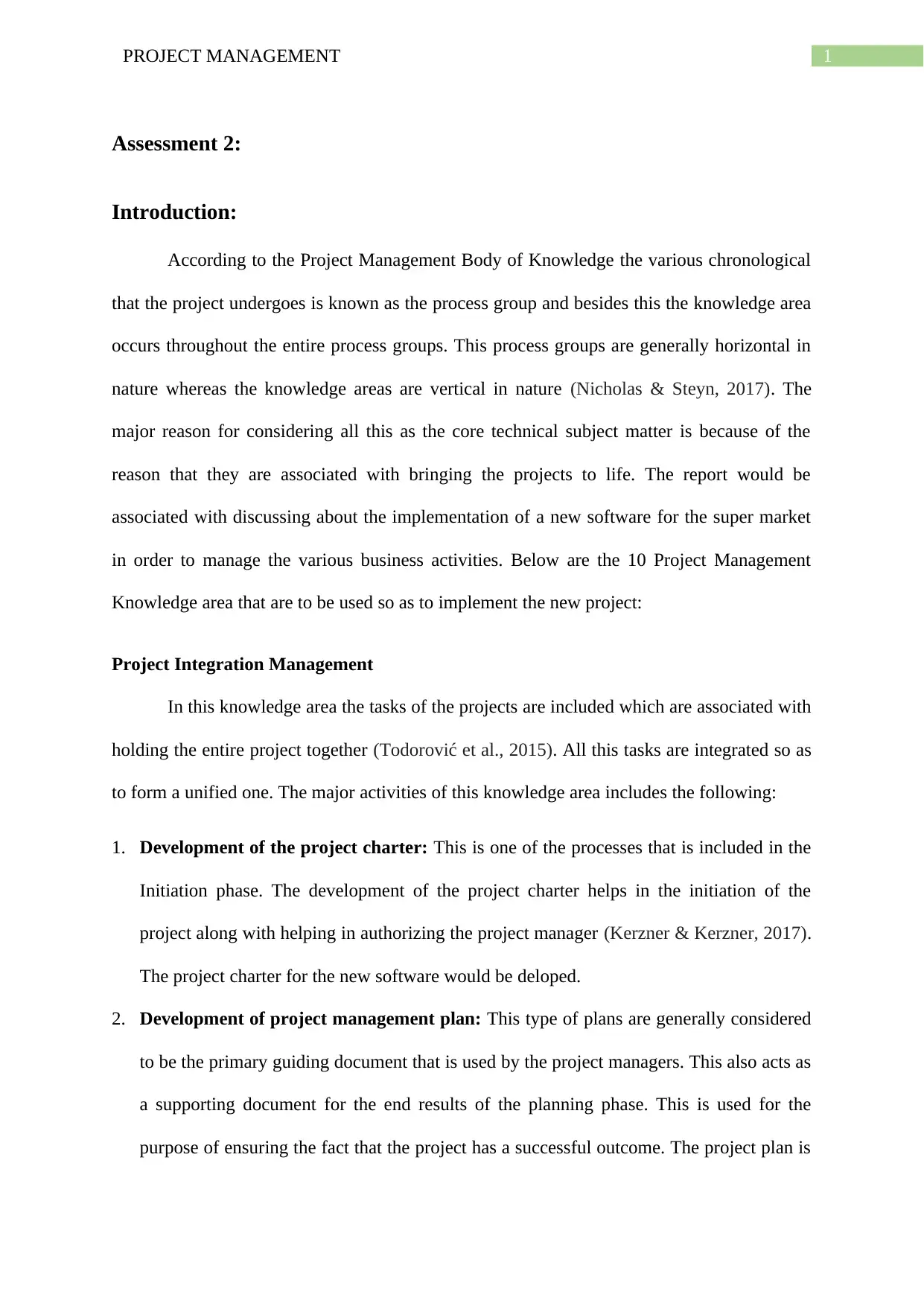
1PROJECT MANAGEMENT
Assessment 2:
Introduction:
According to the Project Management Body of Knowledge the various chronological
that the project undergoes is known as the process group and besides this the knowledge area
occurs throughout the entire process groups. This process groups are generally horizontal in
nature whereas the knowledge areas are vertical in nature (Nicholas & Steyn, 2017). The
major reason for considering all this as the core technical subject matter is because of the
reason that they are associated with bringing the projects to life. The report would be
associated with discussing about the implementation of a new software for the super market
in order to manage the various business activities. Below are the 10 Project Management
Knowledge area that are to be used so as to implement the new project:
Project Integration Management
In this knowledge area the tasks of the projects are included which are associated with
holding the entire project together (Todorović et al., 2015). All this tasks are integrated so as
to form a unified one. The major activities of this knowledge area includes the following:
1. Development of the project charter: This is one of the processes that is included in the
Initiation phase. The development of the project charter helps in the initiation of the
project along with helping in authorizing the project manager (Kerzner & Kerzner, 2017).
The project charter for the new software would be deloped.
2. Development of project management plan: This type of plans are generally considered
to be the primary guiding document that is used by the project managers. This also acts as
a supporting document for the end results of the planning phase. This is used for the
purpose of ensuring the fact that the project has a successful outcome. The project plan is
Assessment 2:
Introduction:
According to the Project Management Body of Knowledge the various chronological
that the project undergoes is known as the process group and besides this the knowledge area
occurs throughout the entire process groups. This process groups are generally horizontal in
nature whereas the knowledge areas are vertical in nature (Nicholas & Steyn, 2017). The
major reason for considering all this as the core technical subject matter is because of the
reason that they are associated with bringing the projects to life. The report would be
associated with discussing about the implementation of a new software for the super market
in order to manage the various business activities. Below are the 10 Project Management
Knowledge area that are to be used so as to implement the new project:
Project Integration Management
In this knowledge area the tasks of the projects are included which are associated with
holding the entire project together (Todorović et al., 2015). All this tasks are integrated so as
to form a unified one. The major activities of this knowledge area includes the following:
1. Development of the project charter: This is one of the processes that is included in the
Initiation phase. The development of the project charter helps in the initiation of the
project along with helping in authorizing the project manager (Kerzner & Kerzner, 2017).
The project charter for the new software would be deloped.
2. Development of project management plan: This type of plans are generally considered
to be the primary guiding document that is used by the project managers. This also acts as
a supporting document for the end results of the planning phase. This is used for the
purpose of ensuring the fact that the project has a successful outcome. The project plan is
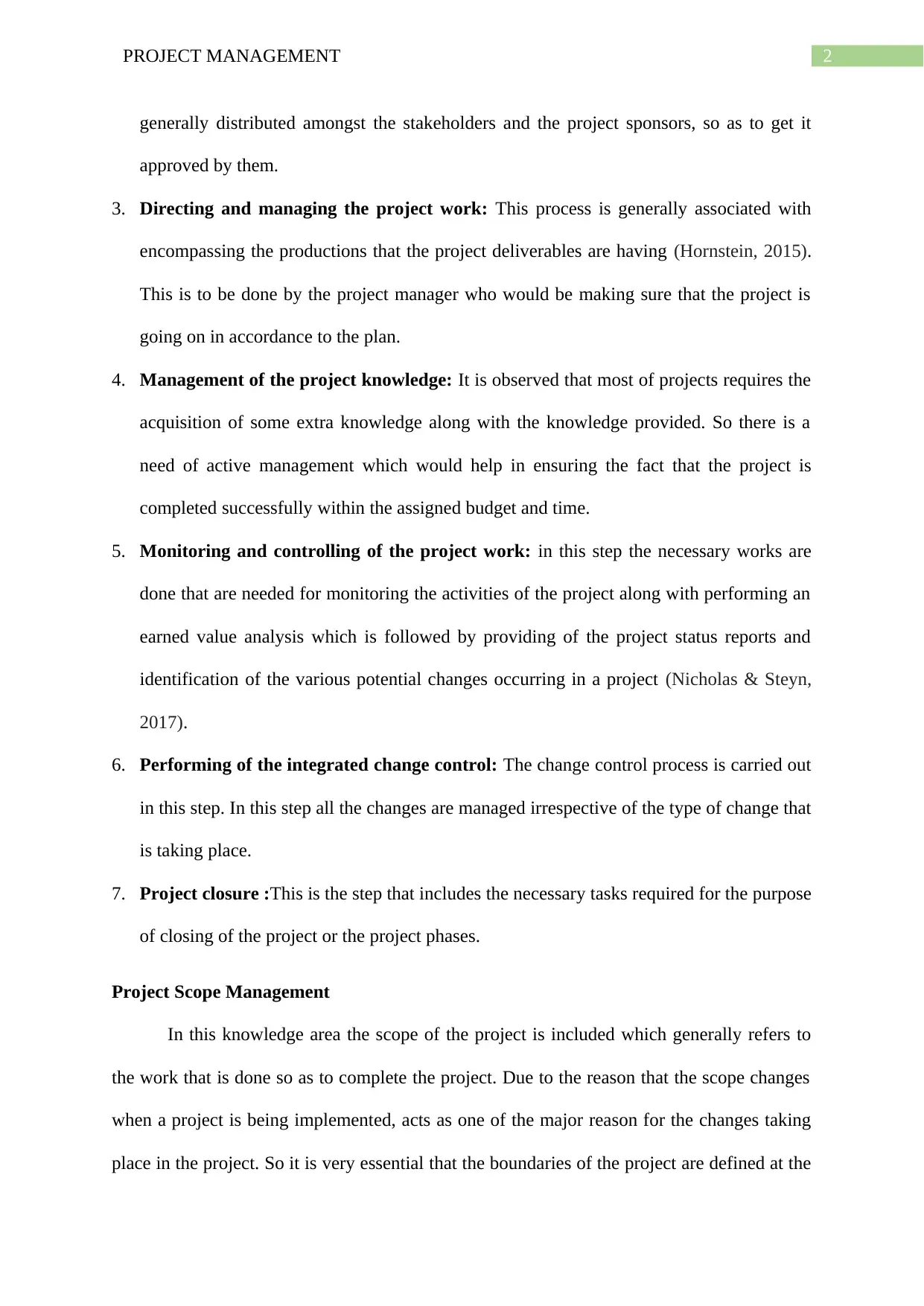
2PROJECT MANAGEMENT
generally distributed amongst the stakeholders and the project sponsors, so as to get it
approved by them.
3. Directing and managing the project work: This process is generally associated with
encompassing the productions that the project deliverables are having (Hornstein, 2015).
This is to be done by the project manager who would be making sure that the project is
going on in accordance to the plan.
4. Management of the project knowledge: It is observed that most of projects requires the
acquisition of some extra knowledge along with the knowledge provided. So there is a
need of active management which would help in ensuring the fact that the project is
completed successfully within the assigned budget and time.
5. Monitoring and controlling of the project work: in this step the necessary works are
done that are needed for monitoring the activities of the project along with performing an
earned value analysis which is followed by providing of the project status reports and
identification of the various potential changes occurring in a project (Nicholas & Steyn,
2017).
6. Performing of the integrated change control: The change control process is carried out
in this step. In this step all the changes are managed irrespective of the type of change that
is taking place.
7. Project closure :This is the step that includes the necessary tasks required for the purpose
of closing of the project or the project phases.
Project Scope Management
In this knowledge area the scope of the project is included which generally refers to
the work that is done so as to complete the project. Due to the reason that the scope changes
when a project is being implemented, acts as one of the major reason for the changes taking
place in the project. So it is very essential that the boundaries of the project are defined at the
generally distributed amongst the stakeholders and the project sponsors, so as to get it
approved by them.
3. Directing and managing the project work: This process is generally associated with
encompassing the productions that the project deliverables are having (Hornstein, 2015).
This is to be done by the project manager who would be making sure that the project is
going on in accordance to the plan.
4. Management of the project knowledge: It is observed that most of projects requires the
acquisition of some extra knowledge along with the knowledge provided. So there is a
need of active management which would help in ensuring the fact that the project is
completed successfully within the assigned budget and time.
5. Monitoring and controlling of the project work: in this step the necessary works are
done that are needed for monitoring the activities of the project along with performing an
earned value analysis which is followed by providing of the project status reports and
identification of the various potential changes occurring in a project (Nicholas & Steyn,
2017).
6. Performing of the integrated change control: The change control process is carried out
in this step. In this step all the changes are managed irrespective of the type of change that
is taking place.
7. Project closure :This is the step that includes the necessary tasks required for the purpose
of closing of the project or the project phases.
Project Scope Management
In this knowledge area the scope of the project is included which generally refers to
the work that is done so as to complete the project. Due to the reason that the scope changes
when a project is being implemented, acts as one of the major reason for the changes taking
place in the project. So it is very essential that the boundaries of the project are defined at the
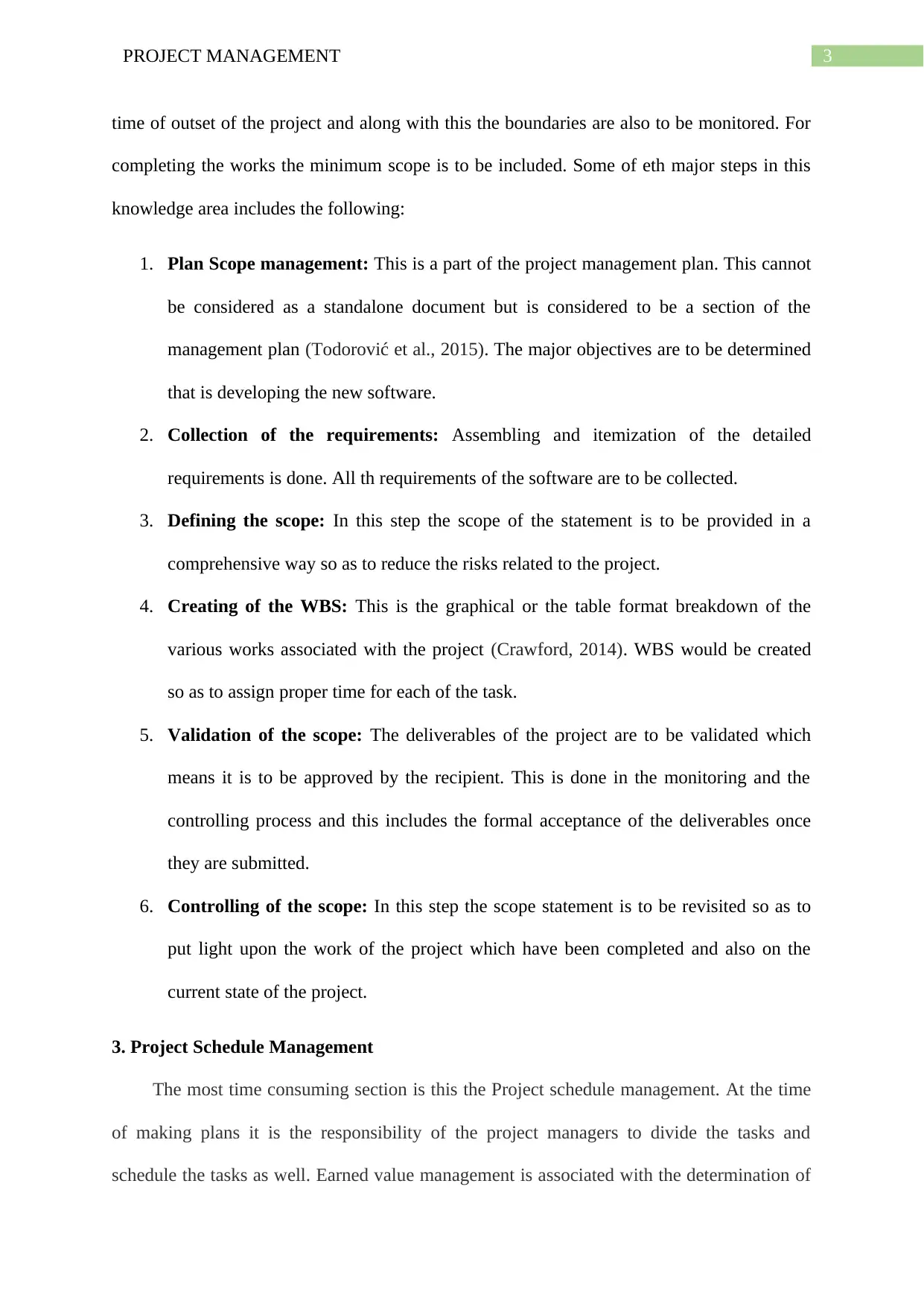
3PROJECT MANAGEMENT
time of outset of the project and along with this the boundaries are also to be monitored. For
completing the works the minimum scope is to be included. Some of eth major steps in this
knowledge area includes the following:
1. Plan Scope management: This is a part of the project management plan. This cannot
be considered as a standalone document but is considered to be a section of the
management plan (Todorović et al., 2015). The major objectives are to be determined
that is developing the new software.
2. Collection of the requirements: Assembling and itemization of the detailed
requirements is done. All th requirements of the software are to be collected.
3. Defining the scope: In this step the scope of the statement is to be provided in a
comprehensive way so as to reduce the risks related to the project.
4. Creating of the WBS: This is the graphical or the table format breakdown of the
various works associated with the project (Crawford, 2014). WBS would be created
so as to assign proper time for each of the task.
5. Validation of the scope: The deliverables of the project are to be validated which
means it is to be approved by the recipient. This is done in the monitoring and the
controlling process and this includes the formal acceptance of the deliverables once
they are submitted.
6. Controlling of the scope: In this step the scope statement is to be revisited so as to
put light upon the work of the project which have been completed and also on the
current state of the project.
3. Project Schedule Management
The most time consuming section is this the Project schedule management. At the time
of making plans it is the responsibility of the project managers to divide the tasks and
schedule the tasks as well. Earned value management is associated with the determination of
time of outset of the project and along with this the boundaries are also to be monitored. For
completing the works the minimum scope is to be included. Some of eth major steps in this
knowledge area includes the following:
1. Plan Scope management: This is a part of the project management plan. This cannot
be considered as a standalone document but is considered to be a section of the
management plan (Todorović et al., 2015). The major objectives are to be determined
that is developing the new software.
2. Collection of the requirements: Assembling and itemization of the detailed
requirements is done. All th requirements of the software are to be collected.
3. Defining the scope: In this step the scope of the statement is to be provided in a
comprehensive way so as to reduce the risks related to the project.
4. Creating of the WBS: This is the graphical or the table format breakdown of the
various works associated with the project (Crawford, 2014). WBS would be created
so as to assign proper time for each of the task.
5. Validation of the scope: The deliverables of the project are to be validated which
means it is to be approved by the recipient. This is done in the monitoring and the
controlling process and this includes the formal acceptance of the deliverables once
they are submitted.
6. Controlling of the scope: In this step the scope statement is to be revisited so as to
put light upon the work of the project which have been completed and also on the
current state of the project.
3. Project Schedule Management
The most time consuming section is this the Project schedule management. At the time
of making plans it is the responsibility of the project managers to divide the tasks and
schedule the tasks as well. Earned value management is associated with the determination of
Secure Best Marks with AI Grader
Need help grading? Try our AI Grader for instant feedback on your assignments.
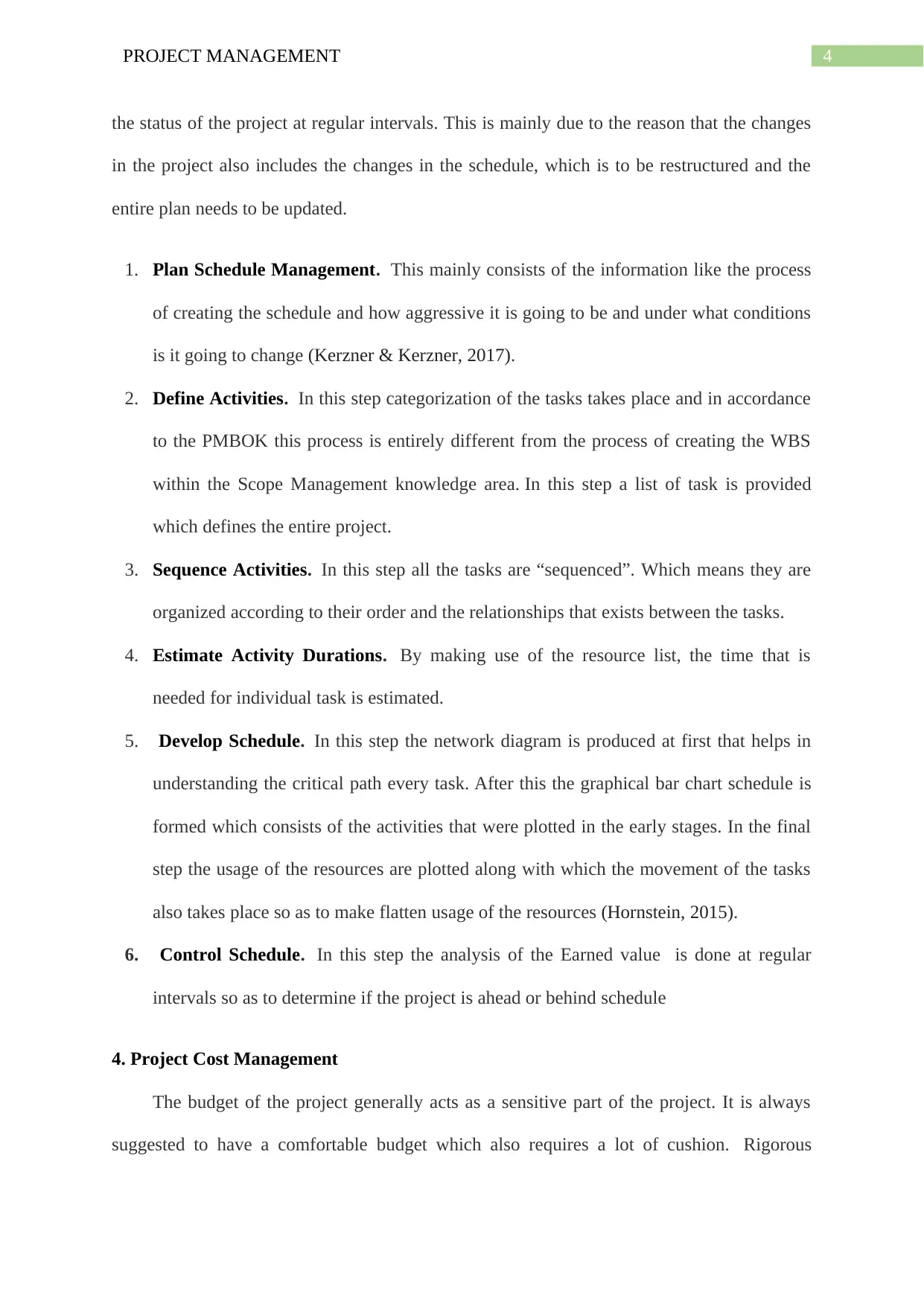
4PROJECT MANAGEMENT
the status of the project at regular intervals. This is mainly due to the reason that the changes
in the project also includes the changes in the schedule, which is to be restructured and the
entire plan needs to be updated.
1. Plan Schedule Management. This mainly consists of the information like the process
of creating the schedule and how aggressive it is going to be and under what conditions
is it going to change (Kerzner & Kerzner, 2017).
2. Define Activities. In this step categorization of the tasks takes place and in accordance
to the PMBOK this process is entirely different from the process of creating the WBS
within the Scope Management knowledge area. In this step a list of task is provided
which defines the entire project.
3. Sequence Activities. In this step all the tasks are “sequenced”. Which means they are
organized according to their order and the relationships that exists between the tasks.
4. Estimate Activity Durations. By making use of the resource list, the time that is
needed for individual task is estimated.
5. Develop Schedule. In this step the network diagram is produced at first that helps in
understanding the critical path every task. After this the graphical bar chart schedule is
formed which consists of the activities that were plotted in the early stages. In the final
step the usage of the resources are plotted along with which the movement of the tasks
also takes place so as to make flatten usage of the resources (Hornstein, 2015).
6. Control Schedule. In this step the analysis of the Earned value is done at regular
intervals so as to determine if the project is ahead or behind schedule
4. Project Cost Management
The budget of the project generally acts as a sensitive part of the project. It is always
suggested to have a comfortable budget which also requires a lot of cushion. Rigorous
the status of the project at regular intervals. This is mainly due to the reason that the changes
in the project also includes the changes in the schedule, which is to be restructured and the
entire plan needs to be updated.
1. Plan Schedule Management. This mainly consists of the information like the process
of creating the schedule and how aggressive it is going to be and under what conditions
is it going to change (Kerzner & Kerzner, 2017).
2. Define Activities. In this step categorization of the tasks takes place and in accordance
to the PMBOK this process is entirely different from the process of creating the WBS
within the Scope Management knowledge area. In this step a list of task is provided
which defines the entire project.
3. Sequence Activities. In this step all the tasks are “sequenced”. Which means they are
organized according to their order and the relationships that exists between the tasks.
4. Estimate Activity Durations. By making use of the resource list, the time that is
needed for individual task is estimated.
5. Develop Schedule. In this step the network diagram is produced at first that helps in
understanding the critical path every task. After this the graphical bar chart schedule is
formed which consists of the activities that were plotted in the early stages. In the final
step the usage of the resources are plotted along with which the movement of the tasks
also takes place so as to make flatten usage of the resources (Hornstein, 2015).
6. Control Schedule. In this step the analysis of the Earned value is done at regular
intervals so as to determine if the project is ahead or behind schedule
4. Project Cost Management
The budget of the project generally acts as a sensitive part of the project. It is always
suggested to have a comfortable budget which also requires a lot of cushion. Rigorous

5PROJECT MANAGEMENT
estimating techniques are to be used so as to establish the budget. Besides this monitoring
should also be done so as to ensure that there is no unnecessary changes.
1. Plan Cost Management. It is essential to establish the Cost Management Plan which
might include the methodologies, which would be used for establishing the project
budget the criteria for changes, and procedures of controlling (Heldman, 2018). The
cost required for each of the phase is to be determined in this step so as to have an
appropriate amount assigned for the project.
2. Estimate Costs. This step includes the estimation of the cost required for completing
individual tasks by considering the various aspects like labour, resources needed and
many more. All this are to be planned properly so as to make sure that there is no
occurrence of budget overrun.
3. Determine Budget. In this step rolling up all the budgets related to the tasks are done
in order to form the final project budget.
4. Control Costs. Conducting of the Earned value analysis is done at regular intervals of
the project so as to determine the status of the project.
5. Project Quality Management
Quality of the project is considered to be one of the triple constrains of a project.
Whenever a good quality project is needed it is essential to investment more time and cost.
Due to this integral nature of the quality, it is essential to establish a quality level during the
planning stage. This is to be specified in project management plan as well. After which the
plan would be associated with dealing with the issues associated with the specification of the
project (Papke-Shields & Boyer-Wright, 2017).
estimating techniques are to be used so as to establish the budget. Besides this monitoring
should also be done so as to ensure that there is no unnecessary changes.
1. Plan Cost Management. It is essential to establish the Cost Management Plan which
might include the methodologies, which would be used for establishing the project
budget the criteria for changes, and procedures of controlling (Heldman, 2018). The
cost required for each of the phase is to be determined in this step so as to have an
appropriate amount assigned for the project.
2. Estimate Costs. This step includes the estimation of the cost required for completing
individual tasks by considering the various aspects like labour, resources needed and
many more. All this are to be planned properly so as to make sure that there is no
occurrence of budget overrun.
3. Determine Budget. In this step rolling up all the budgets related to the tasks are done
in order to form the final project budget.
4. Control Costs. Conducting of the Earned value analysis is done at regular intervals of
the project so as to determine the status of the project.
5. Project Quality Management
Quality of the project is considered to be one of the triple constrains of a project.
Whenever a good quality project is needed it is essential to investment more time and cost.
Due to this integral nature of the quality, it is essential to establish a quality level during the
planning stage. This is to be specified in project management plan as well. After which the
plan would be associated with dealing with the issues associated with the specification of the
project (Papke-Shields & Boyer-Wright, 2017).
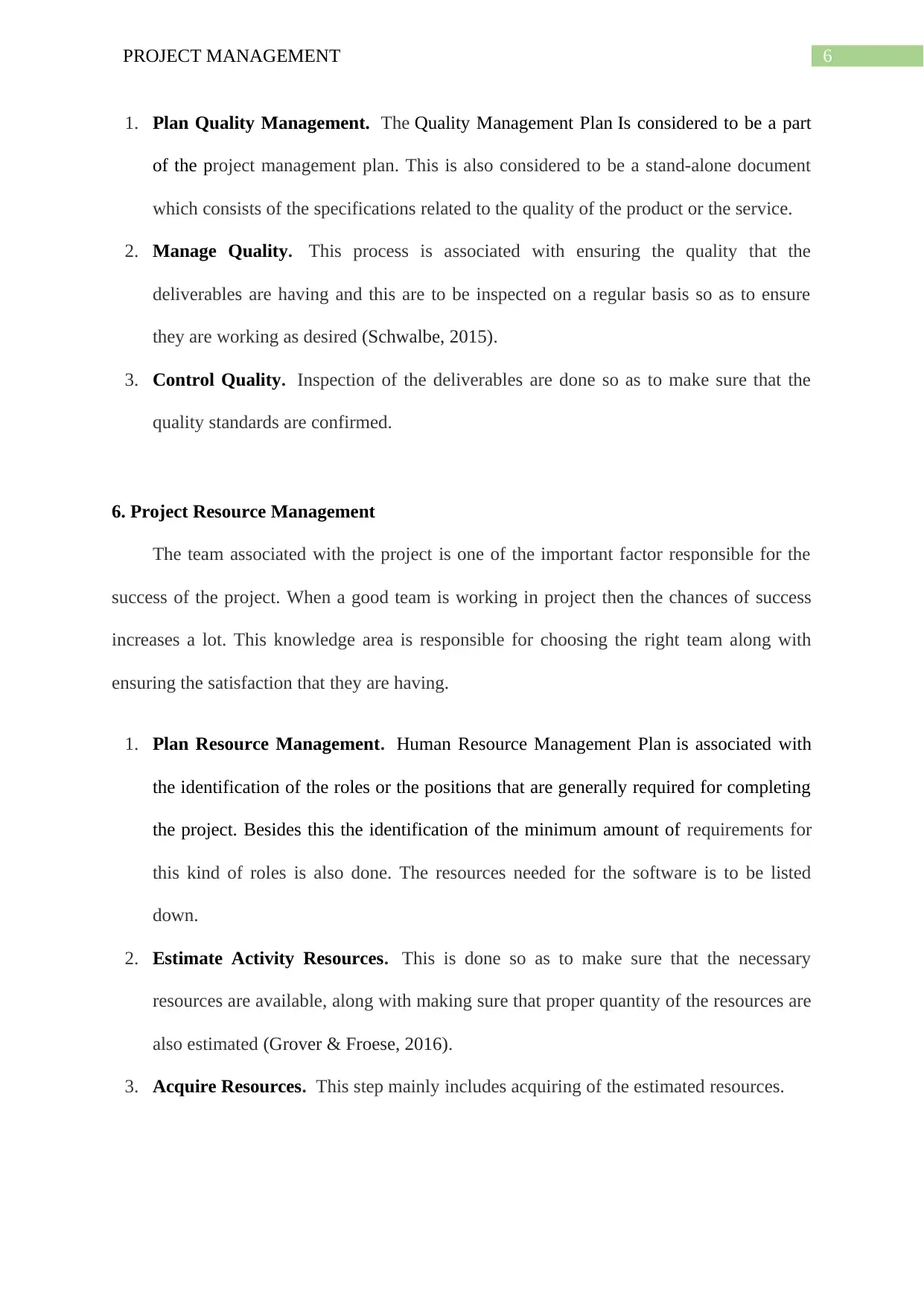
6PROJECT MANAGEMENT
1. Plan Quality Management. The Quality Management Plan Is considered to be a part
of the project management plan. This is also considered to be a stand-alone document
which consists of the specifications related to the quality of the product or the service.
2. Manage Quality. This process is associated with ensuring the quality that the
deliverables are having and this are to be inspected on a regular basis so as to ensure
they are working as desired (Schwalbe, 2015).
3. Control Quality. Inspection of the deliverables are done so as to make sure that the
quality standards are confirmed.
6. Project Resource Management
The team associated with the project is one of the important factor responsible for the
success of the project. When a good team is working in project then the chances of success
increases a lot. This knowledge area is responsible for choosing the right team along with
ensuring the satisfaction that they are having.
1. Plan Resource Management. Human Resource Management Plan is associated with
the identification of the roles or the positions that are generally required for completing
the project. Besides this the identification of the minimum amount of requirements for
this kind of roles is also done. The resources needed for the software is to be listed
down.
2. Estimate Activity Resources. This is done so as to make sure that the necessary
resources are available, along with making sure that proper quantity of the resources are
also estimated (Grover & Froese, 2016).
3. Acquire Resources. This step mainly includes acquiring of the estimated resources.
1. Plan Quality Management. The Quality Management Plan Is considered to be a part
of the project management plan. This is also considered to be a stand-alone document
which consists of the specifications related to the quality of the product or the service.
2. Manage Quality. This process is associated with ensuring the quality that the
deliverables are having and this are to be inspected on a regular basis so as to ensure
they are working as desired (Schwalbe, 2015).
3. Control Quality. Inspection of the deliverables are done so as to make sure that the
quality standards are confirmed.
6. Project Resource Management
The team associated with the project is one of the important factor responsible for the
success of the project. When a good team is working in project then the chances of success
increases a lot. This knowledge area is responsible for choosing the right team along with
ensuring the satisfaction that they are having.
1. Plan Resource Management. Human Resource Management Plan is associated with
the identification of the roles or the positions that are generally required for completing
the project. Besides this the identification of the minimum amount of requirements for
this kind of roles is also done. The resources needed for the software is to be listed
down.
2. Estimate Activity Resources. This is done so as to make sure that the necessary
resources are available, along with making sure that proper quantity of the resources are
also estimated (Grover & Froese, 2016).
3. Acquire Resources. This step mainly includes acquiring of the estimated resources.
Paraphrase This Document
Need a fresh take? Get an instant paraphrase of this document with our AI Paraphraser
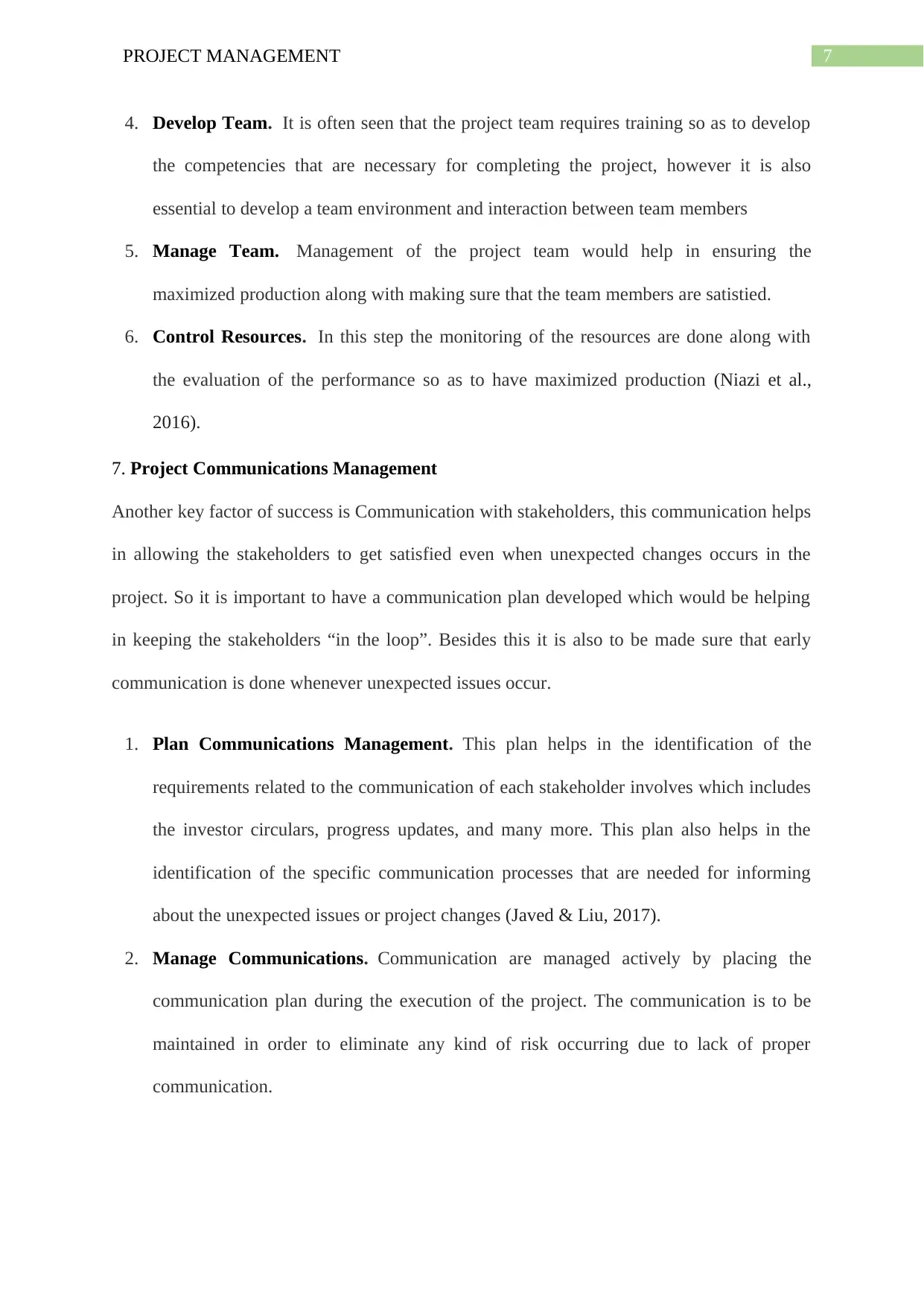
7PROJECT MANAGEMENT
4. Develop Team. It is often seen that the project team requires training so as to develop
the competencies that are necessary for completing the project, however it is also
essential to develop a team environment and interaction between team members
5. Manage Team. Management of the project team would help in ensuring the
maximized production along with making sure that the team members are satistied.
6. Control Resources. In this step the monitoring of the resources are done along with
the evaluation of the performance so as to have maximized production (Niazi et al.,
2016).
7. Project Communications Management
Another key factor of success is Communication with stakeholders, this communication helps
in allowing the stakeholders to get satisfied even when unexpected changes occurs in the
project. So it is important to have a communication plan developed which would be helping
in keeping the stakeholders “in the loop”. Besides this it is also to be made sure that early
communication is done whenever unexpected issues occur.
1. Plan Communications Management. This plan helps in the identification of the
requirements related to the communication of each stakeholder involves which includes
the investor circulars, progress updates, and many more. This plan also helps in the
identification of the specific communication processes that are needed for informing
about the unexpected issues or project changes (Javed & Liu, 2017).
2. Manage Communications. Communication are managed actively by placing the
communication plan during the execution of the project. The communication is to be
maintained in order to eliminate any kind of risk occurring due to lack of proper
communication.
4. Develop Team. It is often seen that the project team requires training so as to develop
the competencies that are necessary for completing the project, however it is also
essential to develop a team environment and interaction between team members
5. Manage Team. Management of the project team would help in ensuring the
maximized production along with making sure that the team members are satistied.
6. Control Resources. In this step the monitoring of the resources are done along with
the evaluation of the performance so as to have maximized production (Niazi et al.,
2016).
7. Project Communications Management
Another key factor of success is Communication with stakeholders, this communication helps
in allowing the stakeholders to get satisfied even when unexpected changes occurs in the
project. So it is important to have a communication plan developed which would be helping
in keeping the stakeholders “in the loop”. Besides this it is also to be made sure that early
communication is done whenever unexpected issues occur.
1. Plan Communications Management. This plan helps in the identification of the
requirements related to the communication of each stakeholder involves which includes
the investor circulars, progress updates, and many more. This plan also helps in the
identification of the specific communication processes that are needed for informing
about the unexpected issues or project changes (Javed & Liu, 2017).
2. Manage Communications. Communication are managed actively by placing the
communication plan during the execution of the project. The communication is to be
maintained in order to eliminate any kind of risk occurring due to lack of proper
communication.
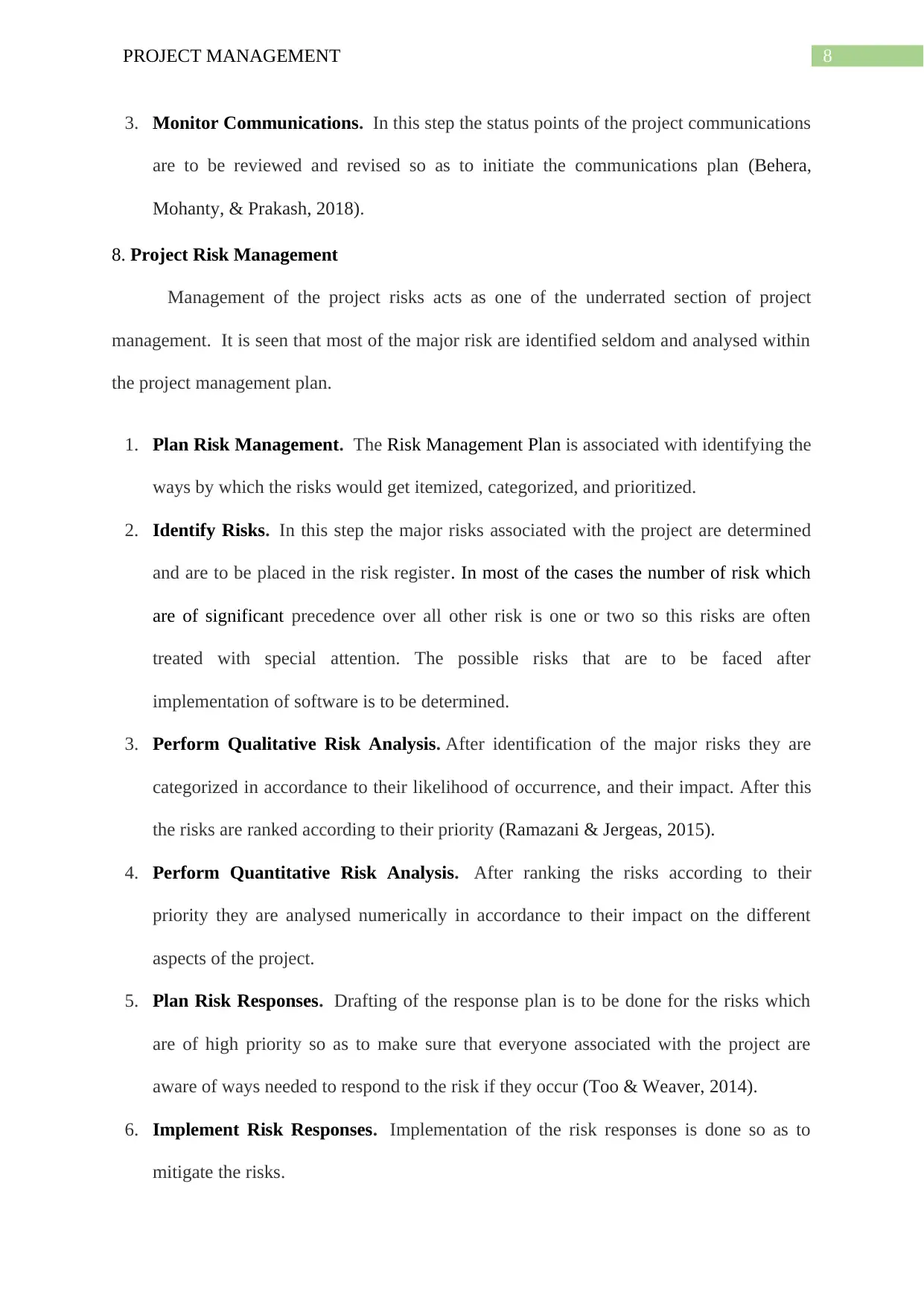
8PROJECT MANAGEMENT
3. Monitor Communications. In this step the status points of the project communications
are to be reviewed and revised so as to initiate the communications plan (Behera,
Mohanty, & Prakash, 2018).
8. Project Risk Management
Management of the project risks acts as one of the underrated section of project
management. It is seen that most of the major risk are identified seldom and analysed within
the project management plan.
1. Plan Risk Management. The Risk Management Plan is associated with identifying the
ways by which the risks would get itemized, categorized, and prioritized.
2. Identify Risks. In this step the major risks associated with the project are determined
and are to be placed in the risk register. In most of the cases the number of risk which
are of significant precedence over all other risk is one or two so this risks are often
treated with special attention. The possible risks that are to be faced after
implementation of software is to be determined.
3. Perform Qualitative Risk Analysis. After identification of the major risks they are
categorized in accordance to their likelihood of occurrence, and their impact. After this
the risks are ranked according to their priority (Ramazani & Jergeas, 2015).
4. Perform Quantitative Risk Analysis. After ranking the risks according to their
priority they are analysed numerically in accordance to their impact on the different
aspects of the project.
5. Plan Risk Responses. Drafting of the response plan is to be done for the risks which
are of high priority so as to make sure that everyone associated with the project are
aware of ways needed to respond to the risk if they occur (Too & Weaver, 2014).
6. Implement Risk Responses. Implementation of the risk responses is done so as to
mitigate the risks.
3. Monitor Communications. In this step the status points of the project communications
are to be reviewed and revised so as to initiate the communications plan (Behera,
Mohanty, & Prakash, 2018).
8. Project Risk Management
Management of the project risks acts as one of the underrated section of project
management. It is seen that most of the major risk are identified seldom and analysed within
the project management plan.
1. Plan Risk Management. The Risk Management Plan is associated with identifying the
ways by which the risks would get itemized, categorized, and prioritized.
2. Identify Risks. In this step the major risks associated with the project are determined
and are to be placed in the risk register. In most of the cases the number of risk which
are of significant precedence over all other risk is one or two so this risks are often
treated with special attention. The possible risks that are to be faced after
implementation of software is to be determined.
3. Perform Qualitative Risk Analysis. After identification of the major risks they are
categorized in accordance to their likelihood of occurrence, and their impact. After this
the risks are ranked according to their priority (Ramazani & Jergeas, 2015).
4. Perform Quantitative Risk Analysis. After ranking the risks according to their
priority they are analysed numerically in accordance to their impact on the different
aspects of the project.
5. Plan Risk Responses. Drafting of the response plan is to be done for the risks which
are of high priority so as to make sure that everyone associated with the project are
aware of ways needed to respond to the risk if they occur (Too & Weaver, 2014).
6. Implement Risk Responses. Implementation of the risk responses is done so as to
mitigate the risks.
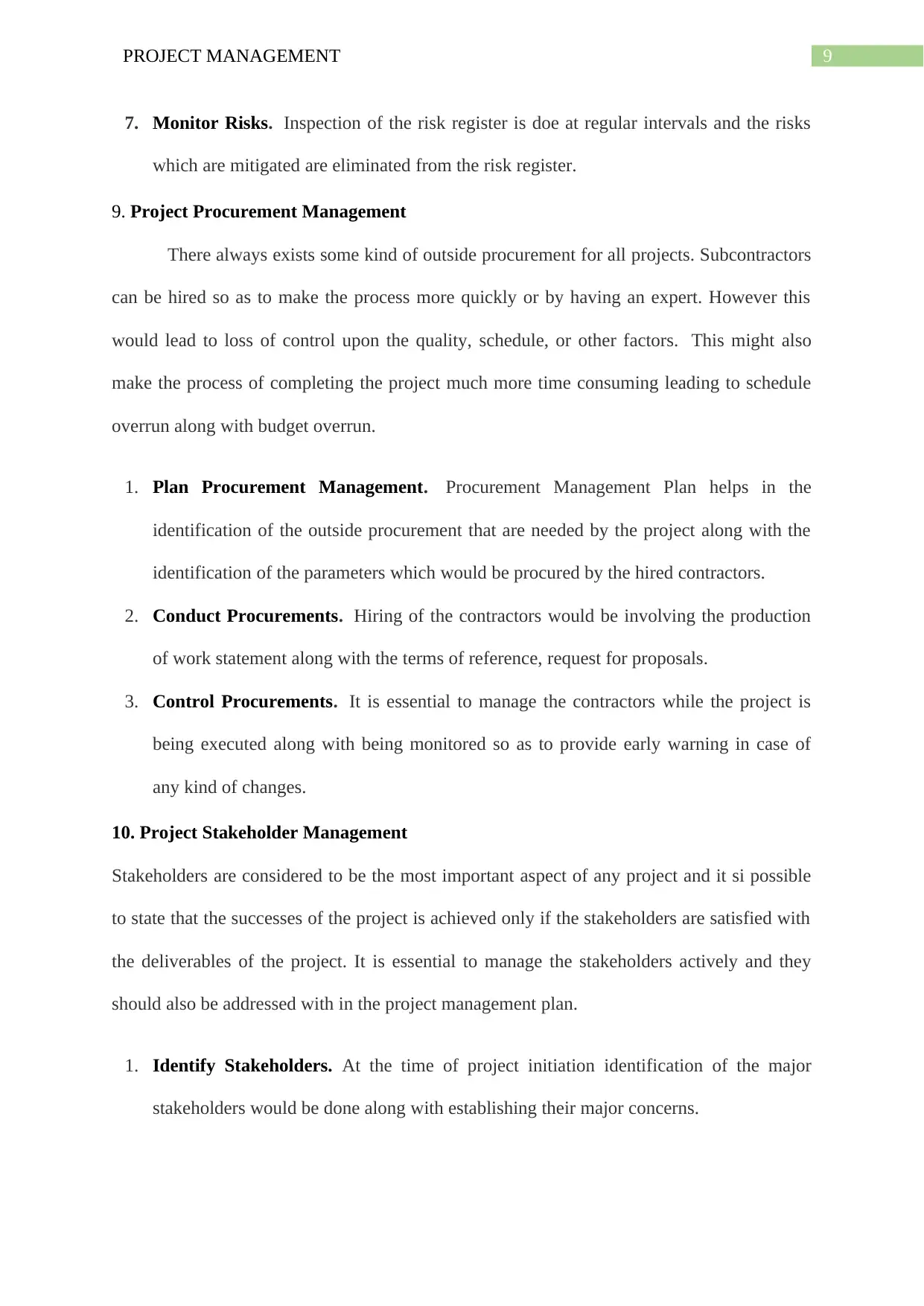
9PROJECT MANAGEMENT
7. Monitor Risks. Inspection of the risk register is doe at regular intervals and the risks
which are mitigated are eliminated from the risk register.
9. Project Procurement Management
There always exists some kind of outside procurement for all projects. Subcontractors
can be hired so as to make the process more quickly or by having an expert. However this
would lead to loss of control upon the quality, schedule, or other factors. This might also
make the process of completing the project much more time consuming leading to schedule
overrun along with budget overrun.
1. Plan Procurement Management. Procurement Management Plan helps in the
identification of the outside procurement that are needed by the project along with the
identification of the parameters which would be procured by the hired contractors.
2. Conduct Procurements. Hiring of the contractors would be involving the production
of work statement along with the terms of reference, request for proposals.
3. Control Procurements. It is essential to manage the contractors while the project is
being executed along with being monitored so as to provide early warning in case of
any kind of changes.
10. Project Stakeholder Management
Stakeholders are considered to be the most important aspect of any project and it si possible
to state that the successes of the project is achieved only if the stakeholders are satisfied with
the deliverables of the project. It is essential to manage the stakeholders actively and they
should also be addressed with in the project management plan.
1. Identify Stakeholders. At the time of project initiation identification of the major
stakeholders would be done along with establishing their major concerns.
7. Monitor Risks. Inspection of the risk register is doe at regular intervals and the risks
which are mitigated are eliminated from the risk register.
9. Project Procurement Management
There always exists some kind of outside procurement for all projects. Subcontractors
can be hired so as to make the process more quickly or by having an expert. However this
would lead to loss of control upon the quality, schedule, or other factors. This might also
make the process of completing the project much more time consuming leading to schedule
overrun along with budget overrun.
1. Plan Procurement Management. Procurement Management Plan helps in the
identification of the outside procurement that are needed by the project along with the
identification of the parameters which would be procured by the hired contractors.
2. Conduct Procurements. Hiring of the contractors would be involving the production
of work statement along with the terms of reference, request for proposals.
3. Control Procurements. It is essential to manage the contractors while the project is
being executed along with being monitored so as to provide early warning in case of
any kind of changes.
10. Project Stakeholder Management
Stakeholders are considered to be the most important aspect of any project and it si possible
to state that the successes of the project is achieved only if the stakeholders are satisfied with
the deliverables of the project. It is essential to manage the stakeholders actively and they
should also be addressed with in the project management plan.
1. Identify Stakeholders. At the time of project initiation identification of the major
stakeholders would be done along with establishing their major concerns.
Secure Best Marks with AI Grader
Need help grading? Try our AI Grader for instant feedback on your assignments.

10PROJECT MANAGEMENT
2. Plan Stakeholder Engagement. Stakeholder Management Plan would be creating a
list of stakeholder which would be followed by the prioritization of their concerns and
potential impacts that they would cause upon the project.
3. Manage Stakeholder Engagement. It is essential to address the needs of the
stakeholders during the execution phase and in addition to this the communication lines
must be kept open.
4. Monitor Stakeholder Engagement. The stakeholders are to be considered during the
status intervals in order to determine the needs of the stakeholders and make any kind of
changes if needed so as to satisfy them.
Conclusion:
The above report helps in concluding to the fact that all the project knowledge areas
are to implement so as to make the software work according to the requirements of the
supermarket. This software would be responsible for controlling all the activities going inside
the organization like managing the sales, keeping track of the inventory and many more. The
software that would be developed and implemented would be consisting of a risk
management plan so as to eliminate any kind of risk. Besides this the entire project would be
managed according the to the project plan so as to complete it within the assigned budget and
time.
2. Plan Stakeholder Engagement. Stakeholder Management Plan would be creating a
list of stakeholder which would be followed by the prioritization of their concerns and
potential impacts that they would cause upon the project.
3. Manage Stakeholder Engagement. It is essential to address the needs of the
stakeholders during the execution phase and in addition to this the communication lines
must be kept open.
4. Monitor Stakeholder Engagement. The stakeholders are to be considered during the
status intervals in order to determine the needs of the stakeholders and make any kind of
changes if needed so as to satisfy them.
Conclusion:
The above report helps in concluding to the fact that all the project knowledge areas
are to implement so as to make the software work according to the requirements of the
supermarket. This software would be responsible for controlling all the activities going inside
the organization like managing the sales, keeping track of the inventory and many more. The
software that would be developed and implemented would be consisting of a risk
management plan so as to eliminate any kind of risk. Besides this the entire project would be
managed according the to the project plan so as to complete it within the assigned budget and
time.
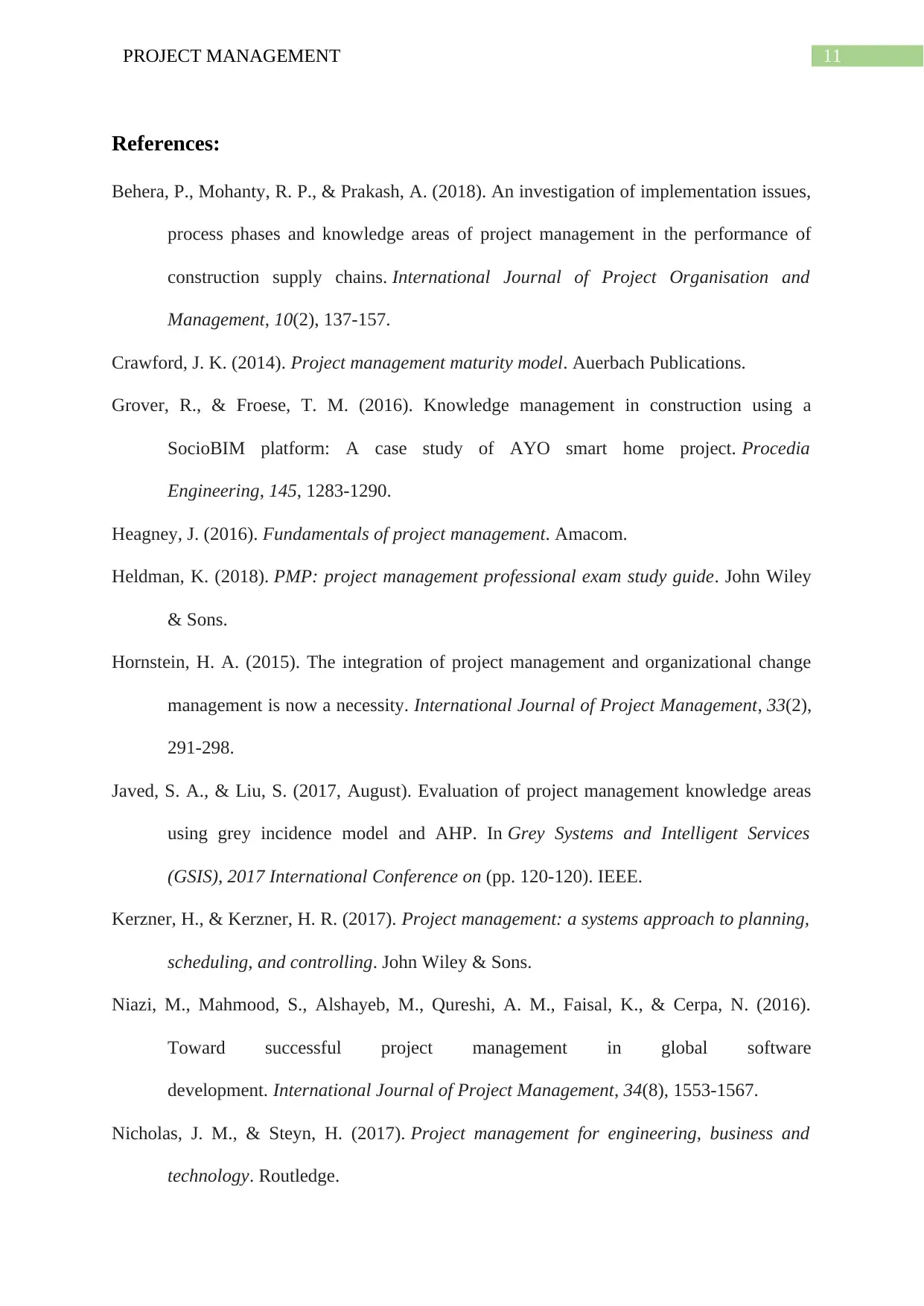
11PROJECT MANAGEMENT
References:
Behera, P., Mohanty, R. P., & Prakash, A. (2018). An investigation of implementation issues,
process phases and knowledge areas of project management in the performance of
construction supply chains. International Journal of Project Organisation and
Management, 10(2), 137-157.
Crawford, J. K. (2014). Project management maturity model. Auerbach Publications.
Grover, R., & Froese, T. M. (2016). Knowledge management in construction using a
SocioBIM platform: A case study of AYO smart home project. Procedia
Engineering, 145, 1283-1290.
Heagney, J. (2016). Fundamentals of project management. Amacom.
Heldman, K. (2018). PMP: project management professional exam study guide. John Wiley
& Sons.
Hornstein, H. A. (2015). The integration of project management and organizational change
management is now a necessity. International Journal of Project Management, 33(2),
291-298.
Javed, S. A., & Liu, S. (2017, August). Evaluation of project management knowledge areas
using grey incidence model and AHP. In Grey Systems and Intelligent Services
(GSIS), 2017 International Conference on (pp. 120-120). IEEE.
Kerzner, H., & Kerzner, H. R. (2017). Project management: a systems approach to planning,
scheduling, and controlling. John Wiley & Sons.
Niazi, M., Mahmood, S., Alshayeb, M., Qureshi, A. M., Faisal, K., & Cerpa, N. (2016).
Toward successful project management in global software
development. International Journal of Project Management, 34(8), 1553-1567.
Nicholas, J. M., & Steyn, H. (2017). Project management for engineering, business and
technology. Routledge.
References:
Behera, P., Mohanty, R. P., & Prakash, A. (2018). An investigation of implementation issues,
process phases and knowledge areas of project management in the performance of
construction supply chains. International Journal of Project Organisation and
Management, 10(2), 137-157.
Crawford, J. K. (2014). Project management maturity model. Auerbach Publications.
Grover, R., & Froese, T. M. (2016). Knowledge management in construction using a
SocioBIM platform: A case study of AYO smart home project. Procedia
Engineering, 145, 1283-1290.
Heagney, J. (2016). Fundamentals of project management. Amacom.
Heldman, K. (2018). PMP: project management professional exam study guide. John Wiley
& Sons.
Hornstein, H. A. (2015). The integration of project management and organizational change
management is now a necessity. International Journal of Project Management, 33(2),
291-298.
Javed, S. A., & Liu, S. (2017, August). Evaluation of project management knowledge areas
using grey incidence model and AHP. In Grey Systems and Intelligent Services
(GSIS), 2017 International Conference on (pp. 120-120). IEEE.
Kerzner, H., & Kerzner, H. R. (2017). Project management: a systems approach to planning,
scheduling, and controlling. John Wiley & Sons.
Niazi, M., Mahmood, S., Alshayeb, M., Qureshi, A. M., Faisal, K., & Cerpa, N. (2016).
Toward successful project management in global software
development. International Journal of Project Management, 34(8), 1553-1567.
Nicholas, J. M., & Steyn, H. (2017). Project management for engineering, business and
technology. Routledge.
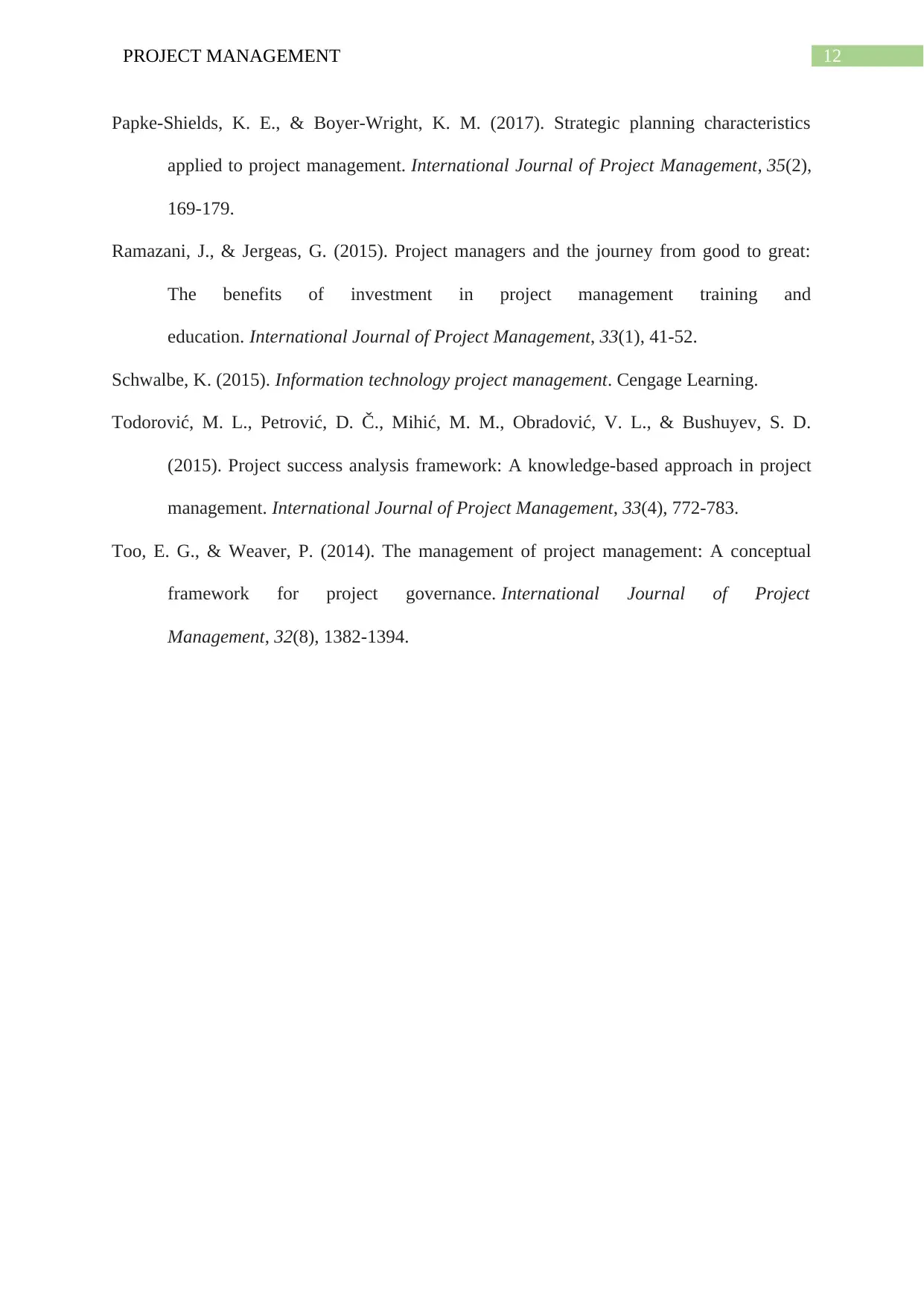
12PROJECT MANAGEMENT
Papke-Shields, K. E., & Boyer-Wright, K. M. (2017). Strategic planning characteristics
applied to project management. International Journal of Project Management, 35(2),
169-179.
Ramazani, J., & Jergeas, G. (2015). Project managers and the journey from good to great:
The benefits of investment in project management training and
education. International Journal of Project Management, 33(1), 41-52.
Schwalbe, K. (2015). Information technology project management. Cengage Learning.
Todorović, M. L., Petrović, D. Č., Mihić, M. M., Obradović, V. L., & Bushuyev, S. D.
(2015). Project success analysis framework: A knowledge-based approach in project
management. International Journal of Project Management, 33(4), 772-783.
Too, E. G., & Weaver, P. (2014). The management of project management: A conceptual
framework for project governance. International Journal of Project
Management, 32(8), 1382-1394.
Papke-Shields, K. E., & Boyer-Wright, K. M. (2017). Strategic planning characteristics
applied to project management. International Journal of Project Management, 35(2),
169-179.
Ramazani, J., & Jergeas, G. (2015). Project managers and the journey from good to great:
The benefits of investment in project management training and
education. International Journal of Project Management, 33(1), 41-52.
Schwalbe, K. (2015). Information technology project management. Cengage Learning.
Todorović, M. L., Petrović, D. Č., Mihić, M. M., Obradović, V. L., & Bushuyev, S. D.
(2015). Project success analysis framework: A knowledge-based approach in project
management. International Journal of Project Management, 33(4), 772-783.
Too, E. G., & Weaver, P. (2014). The management of project management: A conceptual
framework for project governance. International Journal of Project
Management, 32(8), 1382-1394.
1 out of 13
Related Documents
Your All-in-One AI-Powered Toolkit for Academic Success.
+13062052269
info@desklib.com
Available 24*7 on WhatsApp / Email
![[object Object]](/_next/static/media/star-bottom.7253800d.svg)
Unlock your academic potential
© 2024 | Zucol Services PVT LTD | All rights reserved.


